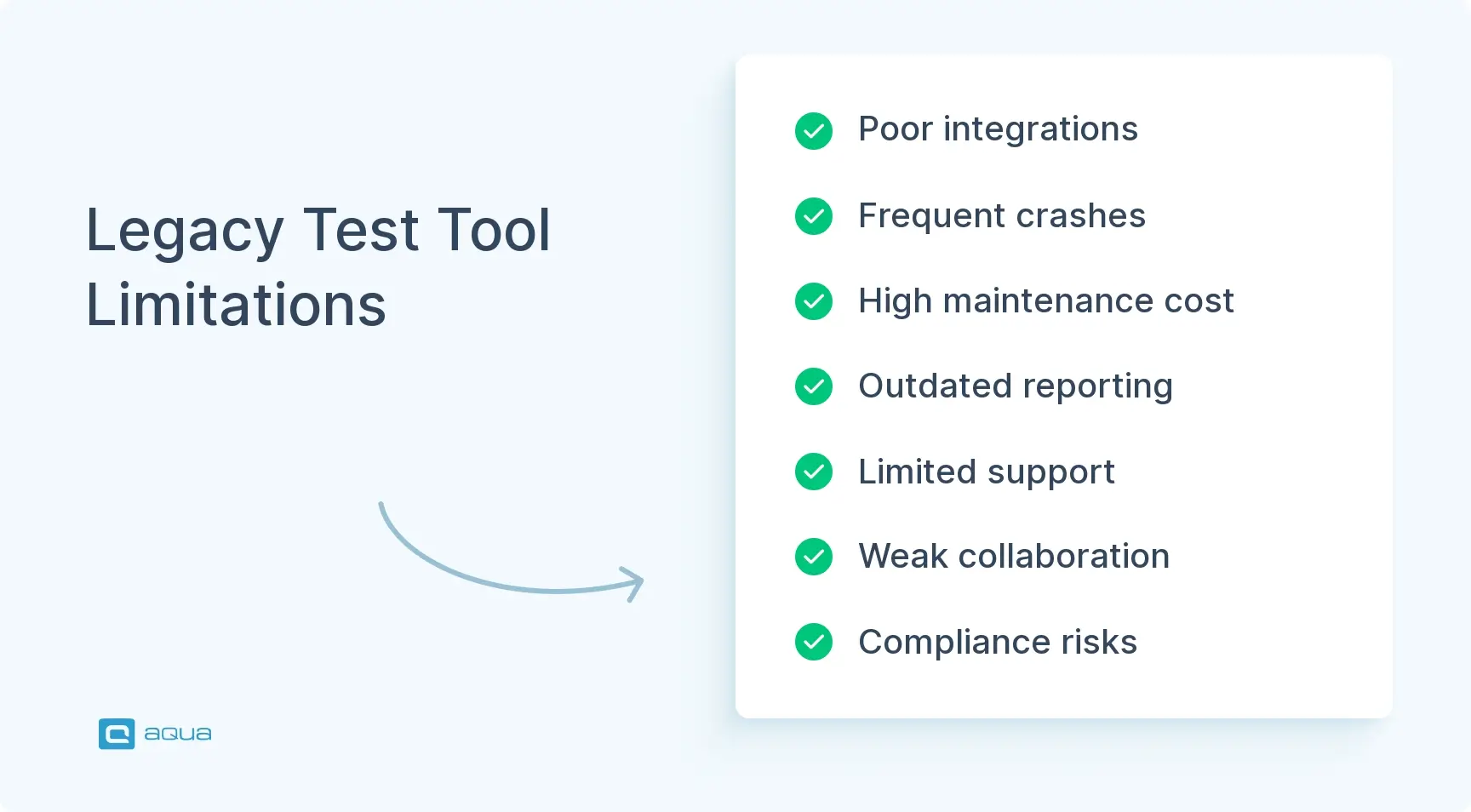Key Takeaways
- Legacy test management tools create isolation with poor integration capabilities, causing teams to waste hours on manual updates between systems.
- Modern test management solutions offer seamless integration with development ecosystems, real-time dashboards, and improved collaboration features lacking in legacy systems.
- Successful migration requires a three-phase approach: recreating test data, integrating with the ecosystem, and expanding capabilities with AI-assisted features.
- Organizations report 40-60% reduction in test creation time and 3-5x increase in test throughput after migrating to modern platforms.
- The migration process should involve cross-functional teams, detailed data mapping, and pilot transfers to minimize disruption during the transition.
Still using that crash-prone test management system from the 2010s while your team spends more time fighting tools than finding bugs? Modern solutions can cut test creation time in half and triple your throughput—but only with the right migration strategy. See exactly how to make the switch without losing your sanity or your data 👇
Common Challenges When Using Legacy Test Management Tools
Legacy systems weren’t built for modern software development. Designed for waterfall methodologies and simpler testing requirements, they struggle in an era of cloud computing, microservices, and Agile test management. Their limitations become more painful with every sprint.
1. Isolation kills productivity
Legacy systems often operate as islands with poor or nonexistent integrations. Your test cases can’t automatically trigger in CI/CD pipelines. Jenkins can’t execute tests after a build, and results don’t flow back to Jira without manual intervention. Testers waste hours copying information between systems and manually updating statuses—work that should be automated isn’t.
2. Performance degrades as you grow
As test suites expand, legacy tools buckle under the weight. Searching across test cases takes minutes instead of seconds. Reports freeze the interface. Crashes, corrupted data, and interface hangs become common. This unreliability turns testing into a bottleneck for release cycles.
3. Limited support and updates
The older the tool, the less it’s supported. Vendor teams may no longer prioritize updates or bug fixes, leaving you with unresolved issues and security risks. Documentation becomes outdated, and any help you do get is slow or insufficient.
4. Skyrocketing costs
Licensing, maintenance fees, custom patches, and specialized staff to maintain legacy tools often cost far more than modern alternatives. Hidden costs add up quickly, eating into your testing budget.
5. Poor collaboration
Teams resort to spreadsheets, email threads, or disconnected tools to share information. Real-time collaboration is nearly impossible, slowing decision-making and increasing errors.
6. Limited visibility
Static offline reports replace real-time dashboards, forcing managers to make decisions with outdated information. Without clear insights, identifying bottlenecks or quality risks becomes difficult.
7. Compliance headaches
Audit trails, version histories, and security features often fall short of modern compliance requirements, creating risk for regulated industries. The final problem? Legacy systems can’t scale to support modern testing approaches. When teams want to implement BDD, integrate with containerized test environments, or perform API testing, these tools become roadblocks instead of enablers. Eventually, switching to a modern test management solution that aligns with current workflows is the only viable option.

Tips for Choosing the Best Test Management Solution
Choosing the right modern test management solution requires looking beyond flashy marketing to assess real-world functionality. The market offers numerous options, but finding the right fit means evaluating what your team actually needs and how you work. A well-chosen platform should eliminate your legacy system’s frustrations while enhancing your testing capabilities.
Start with integration capabilities
This is often the most critical improvement over legacy tools. Modern systems should seamlessly connect with your existing development ecosystem: issue trackers like Jira, CI/CD tools like Jenkins or CircleCI, and version control systems like Git. These integrations create a unified workflow where test cases, requirements, and defects exist in a single source of truth instead of scattered across disconnected platforms.
Support both manual and automated testing
The ideal platform handles your current testing mix while providing a path toward increased automation. Look for features that let testers create, execute, and report on both types of tests from a central hub. The ability to trigger automated test runs from within the tool and consolidate results from various automation frameworks (Selenium, Cypress, etc.) into unified reports dramatically improves visibility.
| Feature Category | Legacy System Limitations | Modern Solution Benefits |
|---|---|---|
| Integrations | Isolated systems, manual updates | API-first design, two-way sync with dev tools |
| Reporting | Static documents, delayed insights | Real-time dashboards with AI-powered analytics |
| Collaboration | Siloed information, email chains | Shared workspaces, in-context commenting |
| Test Data | Manual provisioning, compliance risks | Automated masking, synthetic data generation |
| Scalability | Performance degrades with volume | Cloud-based elastic scaling for enterprise loads |
Prioritize user experience
A system with powerful features won’t deliver value if your team finds it frustrating to use. Request demos with your actual test data. Involve testers in the evaluation process. Watch for intuitive interfaces that reduce the learning curve and features like templates that minimize repetitive work.
Verify security and compliance capabilities
Modern platforms have evolved significantly here. Look for granular permission controls, comprehensive audit trails, and built-in compliance features for standards relevant to your industry (ISO 27001, SOC2, GDPR, HIPAA, etc.). Modern solutions typically offer encryption at rest and in transit, role-based access controls, and detailed logging of all system activities. Features often missing or incomplete in legacy systems.
Assess vendor migration support
The best test management software vendors offer specialized tools, consultants, or proven methodologies to facilitate your transition. They should demonstrate successful migrations from your specific legacy system and provide references from organizations similar to yours who completed the journey. This support dramatically reduces the risk and downtime associated with migration planning steps.
Your legacy test management system creates real bottlenecks. The isolation, performance issues, and integration limitations aren’t just frustrations. They’re actively harming your team’s productivity and effectiveness. This is where a modern solution like aqua cloud transforms your testing capabilities without the migration headaches you expect.
aqua cloud was designed specifically to address legacy system pain points, with specialized migration tools that import your test assets from TestRail, TestLink, Micro Focus ALM/Quality Center, and other platforms while preserving your test structure, attachments, and metadata. Most migrations complete in as little as one day, with dedicated support ensuring your team’s workflow continues uninterrupted. Once migrated, you immediately benefit from seamless integrations with Jira, Jenkins, and other development tools, eliminating the manual updates and siloed information that currently slow you down. The real transformation happens when aqua’s AI Copilot starts generating test cases from requirements in seconds, saving up to 98% of manual effort on test creation. Your team focuses on strategic testing instead of fighting outdated tools or spending hours on repetitive documentation tasks. Time to make your test management system an accelerator instead of a bottleneck.
Eliminate testing bottlenecks and reduce test creation time by 43% with aqua cloud
With the right solution identified, the next challenge is actually making the move.
Migration Planning: The Step-by-Step Process
Transitioning from a legacy test management tool to a modern solution requires careful planning. A haphazard approach leads to lost data, frustrated testers, and project delays. A structured migration process minimizes disruption while setting your team up for long-term success with more powerful testing capabilities.
Start with the right team and inventory
Form a dedicated migration team with representatives from QA, development, and operations. This cross-functional group ensures all perspectives are considered. Together, take inventory of your current testing assets: test cases, scenarios, results, requirements, and defects. Determine which items need to be migrated. This is also your chance to clean house. Archive obsolete tests instead of carrying technical debt into your new system.
Develop a phased timeline
Create a detailed timeline with clear milestones and dependencies. Most successful migrations happen in phases, not as a big bang cutover. Schedule the migration during low-activity periods like weekends or between major releases. Build in buffer time for unexpected issues. Communicate this timeline broadly to set expectations and ensure stakeholders understand when systems may be unavailable.
I used migration as an opportunity to reevaluate which tests actually mattered and to rewrite all of the ones being kept. Thins included making sure that the coding practices were kept, cruft creeps into all code bases over time.
Create detailed mapping between systems
Document how fields, statuses, and relationships in your legacy tool translate to the new platform. This mapping guide becomes your blueprint during actual data transfer and helps resolve any ambiguities. Most vendors provide templates or consultants to assist with this critical step. The mapping often determines migration success or failure.
Run a pilot before full migration
Perform a pilot transfer with a subset of your data before executing the full migration. This trial run reveals potential issues with data formatting, field mapping, or integration points. It also provides an opportunity to train key users on the new system with familiar data, creating internal champions who can help their colleagues adapt during the full rollout.
Throughout this process, maintain open communication with your vendor’s migration specialists. Their experience with similar transitions helps you avoid common pitfalls and leverage best practices. By the time you reach actual cutover, you should have a tested plan, trained users, and confidence that your testing assets will transfer successfully.
Phase One: Recreating Test Data Jobs
The first migration phase focuses on transferring your test cases, scenarios, and data to the new platform while preserving their structure and relationships. This foundational step ensures your testing assets remain intact and functioning before more complex integrations occur.
Export from your legacy system
Begin by exporting your test assets from the legacy system, typically using built-in export functions or API access. Most legacy tools allow export to CSV, XML, or Excel formats, though the quality and completeness of these exports vary significantly. Work with your vendor to determine the optimal export method for your specific legacy tool. They may have specialized connectors or scripts for more reliable extraction.
Clean and prepare your data
Once exported, the data requires preparation before import. Clean inconsistent formatting, standardize naming conventions, and resolve duplicate entries. Modern tools often have more structured data models than legacy systems, so this preparation ensures your data fits the new framework. Many organizations report that this cleanup, while time-consuming, delivers unexpected benefits by exposing quality issues and redundancies in their test assets.
Import and validate
With prepared data in hand, begin the import process using your vendor’s recommended methodology. This typically involves mapping fields from your export files to their corresponding locations in the new system. Pay special attention to custom fields, relationships between test cases, and test execution history. The goal is preserving as much context and historical data as possible while leveraging the improved structure of the modern platform.
Key aspects during Phase One:
- Prioritize migrating active test cases over historical or archived tests
- Preserve relationships between requirements, test cases, and defects
- Validate test data immediately after import by comparing key metrics (test counts, pass/fail rates)
- Document any workarounds or compromises made during migration for future reference
- Train key users on basic navigation and test execution in the new system before proceeding
Once your core test assets are successfully imported and validated, you’ve completed the foundational phase. Your testing capabilities now exist in the new system, allowing you to begin integrating these assets with your broader development ecosystem.
With your test assets migrated, the next phase connects them to your development workflow.
Phase Two: Integration into Ecosystem
With your test assets successfully transferred, the second phase connects your new test management system to your broader development and delivery ecosystem. This integration phase transforms your standalone tool into a cohesive part of your end-to-end software development lifecycle.
Map your integration requirements
Identify all systems that need to communicate with your test management tool: issue trackers, CI/CD pipelines, requirement management systems, and automation frameworks. Prioritize these integrations based on their impact on daily workflows. Connections that eliminate manual data entry should typically take precedence.
Choose the right integration approach
Modern test management platforms offer various integration mechanisms: native connectors, REST APIs, and webhooks. Work with your vendor to determine the optimal approach for each integration point. Native connectors (like pre-built Jira or Jenkins plugins) offer the fastest implementation but may have limited customization. API-based integrations require more development effort but provide greater flexibility for tailored workflows.
Connect your CI/CD pipeline
Configure your pipelines to trigger automated tests through your new test management system. This connection allows test results to flow automatically into your test repository, creating a continuous feedback loop. Most modern platforms can trigger test runs in response to build events and then aggregate results from various automation tools into unified dashboards.
Establish bi-directional traceability
When connecting to requirement management systems or Agile planning tools, focus on establishing bi-directional traceability. Changes to requirements should cascade to associated test cases, while test results should be visible in your planning tool to inform release decisions. This traceability is often a significant improvement over legacy systems, which frequently required manual updates to maintain alignment.
Involve your team in testing integrations
Throughout this phase, involve both testers and developers in configuring and testing integrations. Their collaborative input ensures the connections support real-world workflows instead of theoretical processes. As each integration comes online, monitor it closely for the first few cycles to confirm data flows correctly in both directions.
The completion of this phase marks a significant milestone. Your testing activities are now integrated with your development processes, eliminating the silos that legacy tools created. This integration lays the groundwork for expanding your testing capabilities beyond what was possible before.
Phase Three: Expanding Capabilities
The final migration phase focuses on leveraging your modern test management platform’s advanced capabilities to improve testing efficiency and effectiveness. This expansion phase is where you see the most transformative benefits compared to your legacy system.
Implement automated reporting and analytics
Modern platforms offer real-time dashboards that provide insights into test coverage, execution trends, and defect patterns. Configure these dashboards to highlight key metrics for different stakeholders. Executives want high-level quality indicators. Test managers need detailed execution statistics. These visualizations replace the static, point-in-time reports of legacy systems with dynamic views that inform decisions as they happen.
Explore advanced test data management
Modern platforms often include features for data masking, synthetic data generation, and on-demand provisioning that were unavailable in legacy tools. These capabilities help address the growing challenges of test data management in privacy-conscious environments. By automating the creation and management of test data, you accelerate testing while maintaining compliance with regulations like GDPR.
Scale test automation with AI assistance
Many modern platforms now offer capabilities that automatically generate test cases from requirements, identify redundant tests, or suggest updates when application changes are detected. These AI tools dramatically reduce the maintenance burden of large test suites and help teams achieve higher automation coverage with less effort.
| Capability | Legacy Limitation | Modern Solution | Business Impact |
|---|---|---|---|
| Test Creation | Manual, time-intensive process | AI-assisted generation from requirements | 40-60% reduction in test creation time |
| Test Execution | Limited parallel execution, manual triggering | Automated scheduling, cloud execution | 3-5x increase in test throughput |
| Test Analysis | Delayed, manual analysis of results | Real-time anomaly detection and trending | Faster defect identification, reduced escaped bugs |
| Test Data | Manual provisioning, compliance risks | Automated masking and generation | Reduced compliance risk, faster test cycles |
Encourage structured experimentation
Assign team members to explore specific features and report back on potential applications to your testing processes. This approach builds internal expertise while identifying the most valuable capabilities for your specific context.
Track improvements against baseline
Throughout this phase, measure improvements against your pre-migration baseline. Track metrics like test creation time, execution speed, and defect detection rates. These measurements provide quantifiable evidence of the migration’s impact and help justify the investment while identifying areas for further optimization.
The completion of this final phase represents a transformation of your testing capabilities. You’ve not only replaced a legacy tool but evolved your entire approach to quality assurance. Your team now has access to capabilities that enable faster, more thorough testing aligned with modern development practices.
Ready to make the move from your legacy system to something better?
Conclusion
Migrating from a legacy test management tool to a modern platform is a strategic move that transforms your QA capabilities and improves your entire software delivery process. The journey requires careful planning: identifying your current system’s limitations, selecting the right replacement, and executing a phased migration. Each step builds on the last, first recreating your existing test assets, then integrating them with your development ecosystem, and finally expanding into capabilities that weren’t possible before. The rewards extend far beyond eliminating frustrations. Modern test management platforms like aqua cloud offer real-time visibility, seamless integration with development processes, advanced analytics, and automated test data management. These capabilities directly impact release quality and speed. Organizations that complete this journey frequently report not just incremental improvements but transformative changes in how they approach quality assurance. Your legacy system is holding you back. The path forward is clear. Time to make the move.
aqua cloud offers everything you need for a successful migration: comprehensive import wizards, specialized mapping tools, and expert support to ensure your test assets transfer seamlessly while preserving their structure and relationships. But migration is just the beginning. Once implemented, aqua’s unified repository becomes your single source of truth, with real-time dashboards replacing static reports and AI-driven test generation reducing creation time by up to 98%. The platform’s open API architecture connects seamlessly with your development ecosystem, ensuring test cases, requirements, and defects stay in perfect synchronization without manual intervention. Most importantly, aqua helps you expand beyond the limitations of your legacy system with capabilities like AI-assisted test creation, automated test data management, and advanced analytics that weren’t possible before. Organizations using aqua report not just incremental improvements but transformative changes in testing efficiency and effectiveness. Why continue patching an outdated system when you could be leading the way with modern, AI-powered test management?
Transform your testing capabilities and achieve seamless integration across your development ecosystem

















